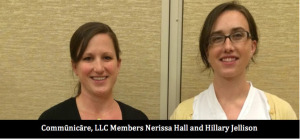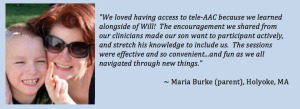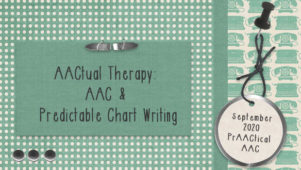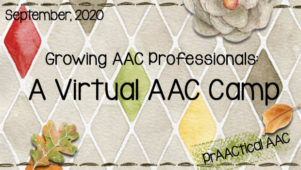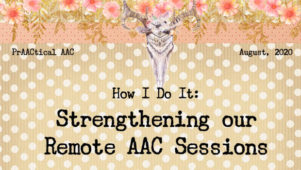How We Do It: Tele-AAC with Nerissa Hall and Hillary Johnson
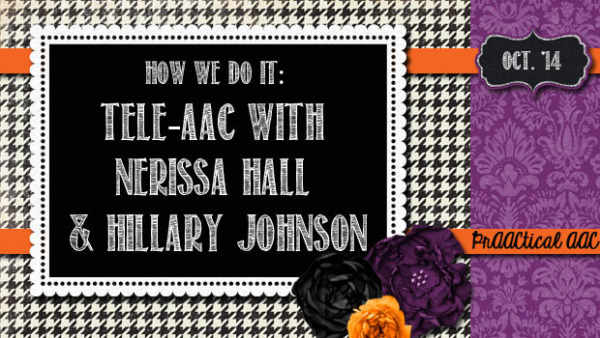
Have you been hearing a lot about telepractice lately and are wondering how that works when the client has AAC needs? In this post, we turn to Nerissa Hall and Hillary Jellison of Communicare who tell us how they use it in their clinical practice. Nerissa and Hillary are both SLPs and assistive technology practitioners specializing in AAC, AT, and telepractice/tele-AAC. They have worked together for a number of years and are the proud owners of Commūnicāre, LLC, organization based in Western Mass and CT, that offers intervention, consultation, and evaluation services focusing on supporting an individuals, or a team’s, success and independence through implementation of AAC, AT and innovative and evidence-based practices. We are committed to our clinical work, as well as translational research and are members of the C.A.R.E. Consortium.
Tele-AAC: A Powerful Way of Supporting Individuals Using AAC
Telepractice, which is used to provide professional services by linking clinicians to clients, irrespective of their location, through the application of telecommunications technology (ASHA, n.d.), can be an effective way to provide evidence-based speech-language services. According to ASHA, telepractice is being used in the assessment and treatment of a variety of speech and language disorders, such as articulation, language, cognitive, voice and fluency disorders, as well as autism, dysarthria, and dysphagia (ASHA, n.d.). To date, there is limited, yet emerging evidence regarding the efficacy of telepractice as a service delivery method for individuals using Augmentative and Alternative Communication (AAC).
So, What is Tele-AAC?
Tele-AAC is the use of telepractice specifically for individuals using or working with those using AAC. Tele-AAC is a “unique cross-disciplinary clinical service delivery model that requires expertise in both telepractice and augmentative and alternative communication (AAC) systems” (Anderson, et al., 2012, p. 80). Tele-AAC can be applied for intervention, assessment, consultation, training and other AAC-related services; enabling individuals and teams in need of AAC services to connect directly with an AAC specialist irrespective of their geographical locale.
Tele-AAC services can be direct, face-to-face intervention services with an individual using AAC (also known as synchronous services). In addition, AAC specialists can offer consultation and training to parents and professionals supporting individuals using AAC by watching intervention sessions through video-conferencing software and providing feedback in the moment (also considered a synchronous services), immediately following the session, or even a week later (the latter two are considered asynchronous services).

Direct tele-AAC services can vary depending on the type of device being used by the individual, their different skills, and their areas of need. In order for services to be effective the clinician needs to be able to view the individual’s AAC system and see what the individual is inputting into their device. In addition, evidence-based AAC intervention strategies require AAC modeling (or aided language stimulation) from the clinician.
It is these added layers of needing to visualize the client’s device, as well as model on a device that makes direct tele-AAC services seemingly more challenging. However, advancements in technology make it possible and just as effective, in some cases, as offering in-person services (Hall, 2013). The clinician is able to view and model target phrases by either:
- Inputting text into shared documents with word processing capabilities;
- Using specialized webcam mounts, such as the Adjustable J-Mount (Larivee, 2012), to display the AAC screen from one or two AAC systems;
- Screen-sharing simulation software; or
- Using dedicated AAC systems with Internet connectivity.
Each of these different methods of direct tele-AAC varies with respect to the equipment needed by the client and clinician, as well as the skills of the client (Commūnicāre, LLC, 2014; Hall & Boisvert, 2014).

Tele-AAC, and telepractice for that matter, is not for everyone. Client candidacy needs to be carefully assessed and a thorough needs assessment needs to be conducted in order to ensure that telepractice is appropriate and feasible for the individual and given the technological infrastructure available to the individual using AAC.
Here’s an Example of How It Works
 In this example, the client and the clinician are engaging in direct tele-AAC using two speech generating devices (SGDs). The client is using a Prentke Romich Vantage Lite with a 60 Sequenced overlay. The clinician has the same device with a replica of the client’s overlay to ensure for accurate AAC modeling. The client and clinician are engaged in a shared, interactive book-reading activity (using Big Universe). Through GoToMeeting (a secure video-conferencing service), the client and clinician are able to share their image, share the images of their respective devices (using the J-Mount which is connected to a secondary computer in both the client and the clinician’s settings), and engage in the activity, which is screen-shared from the clinician’s computer. Here is a video of it in action:
In this example, the client and the clinician are engaging in direct tele-AAC using two speech generating devices (SGDs). The client is using a Prentke Romich Vantage Lite with a 60 Sequenced overlay. The clinician has the same device with a replica of the client’s overlay to ensure for accurate AAC modeling. The client and clinician are engaged in a shared, interactive book-reading activity (using Big Universe). Through GoToMeeting (a secure video-conferencing service), the client and clinician are able to share their image, share the images of their respective devices (using the J-Mount which is connected to a secondary computer in both the client and the clinician’s settings), and engage in the activity, which is screen-shared from the clinician’s computer. Here is a video of it in action: 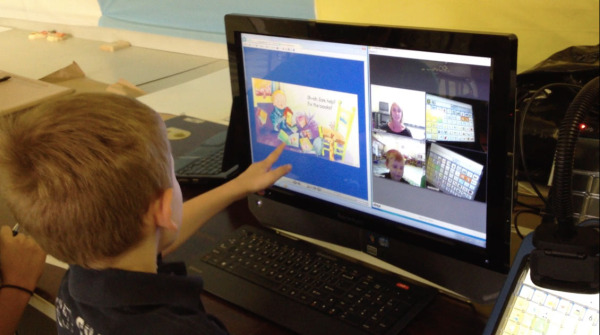
What Else Makes Tele-AAC Unique?
Tele-AAC not only empowers clients and clinicians specializing in AAC to connect irrespective of where they are based, it also enables individuals using AAC to get evidence-based services from highly qualified professionals, empowers clinicians to support parents and professionals working with individuals using AAC while in the context of real-time intervention, and by “tuning in” to the online session parents and other caregivers can be involved and better support generalization to the home, school or vocational environment.
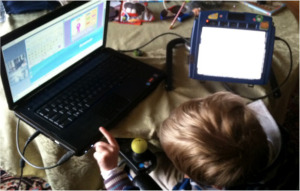 In this case example, the client, Will, received services at home. His parents were therefore able to participate in the sessions. They helped set up the equipment and login to the tele-AAC session. In addition, they were involved in the session, working alongside their son to find target words, generate specific phrases, conjugate verbs, and ultimately support their son’s use of his AAC system not only during the session, but outside of it as well.
In this case example, the client, Will, received services at home. His parents were therefore able to participate in the sessions. They helped set up the equipment and login to the tele-AAC session. In addition, they were involved in the session, working alongside their son to find target words, generate specific phrases, conjugate verbs, and ultimately support their son’s use of his AAC system not only during the session, but outside of it as well.
In Conclusion
Tele-AAC has the potential to drastically improve access to services for individuals using AAC. Where there may not be an AAC specialist in the area, individuals, families, school districts and/or work places can connect to professionals via the Internet. The advancements in technology make it possible for clinicians to implement evidence-based techniques, such as AAC modeling and aided language stimulation, to support the skill advancement of their clients. Again, client candidacy and the technological infrastructure need to be carefully assessed, but it is encouraging to know that there are new ways to support those using AAC.
:::::::::::::::::::::::::::::::::::::::
You can get Hillary and Nerissa’s Madlibs activity here and their Rainbow Sentences visual support here.
Resources:
Filed under: PrAACtical Thinking
Tagged With: Hillary Johnson, Nerissa Hall, telepractice
This post was written by Carole Zangari
